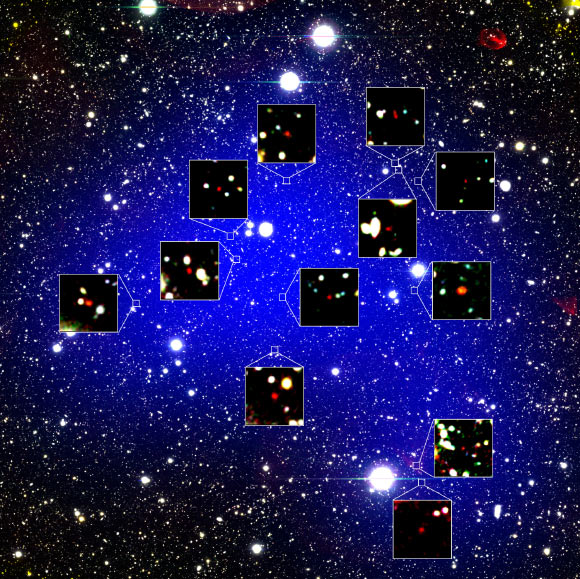13-Billion-Year-Old Galaxy Protocluster Found | Astronomy – Sci-News.com
Using the Subaru, Keck, and Gemini telescopes, astronomers have discovered a young cluster of galaxies in the early Universe. Named z66OD, the protocluster contains at least 12 huge galaxies and is 13 billion light-years away. It is the earliest galaxy protocluster ever observed, meaning such large-scale structures were around very early in the Universe’s existence.

The z66OD protocluster: the blue shading shows the calculated extent of the protocluster, and the bluer color indicates higher density of galaxies in the protocluster; the red objects in zoom-in figures are the 12 galaxies found in it. Image credit: NAOJ / Harikane et al.
“Tracing the formation of the largest structures in the Universe, and the galaxies inside them, is the new frontier in extragalactic astronomy,” said Imperial College London’s Dr. Dave Clements, co-author of the study.
“This result pushes that frontier back still further, and provides some hints as to the processes behind protocluster galaxy formation.”
The Subaru Telescope had previously spotted a giant gaseous nebula called Himiko in the region, and the closer inspection revealed Himiko is a massive galaxy, accompanied by 11 other complete galaxies.
“A protocluster is a rare and special system with an extremely high density, and not easy to find,” said lead author Dr. Yuichi Harikane, an astronomer at the National Astronomical Observatory of Japan (NAOJ).
“To overcome this problem, we used the wide field of view of the Subaru Telescope to map a large area of the sky and look for protoclusters.”
In the map of the Universe made by the Subaru Telescope, the researchers first discovered a candidate of a protocluster in a location where galaxies were 15 times more concentrated than expected.
They conducted follow-up observations using the Keck and Gemini telescopes and confirmed the z66OD protocluster.
In the Subaru map, they also spotted another protocluster, named z57OD, which contains at least 44 galaxies and resides some 12.7 billion light-years away from Earth.
Furthermore, the team discovered that the number of stars forming inside the z66OD protocluster is five times larger than other galaxies with similar masses in the same period of the Universe.
“We believe this is because of the large amount of gas in the system, a crucial ingredient for star formation, and eventually, galaxy formation,” the scientists said.
They were also surprised to discover that the massive Himiko galaxy was not in the center of the z66OD protocluster, but on the edge, around 500 million light-years away from the center.
“It is still not understood why Himiko is not located in the center of z66OD,” said study co-author Dr. Masami Ouchi, from the NAOJ and the University of Tokyo.
“This result will be a key to understanding the connection between galaxy clusters and massive galaxies.”
The discovery is reported in a paper in the Astrophysical Journal.
_____
Yuichi Harikane et al. 2019. SILVERRUSH. VIII. Spectroscopic Identifications of Early Large-scale Structures with Protoclusters over 200 Mpc at z ~ 6–7: Strong Associations of Dusty Star-forming Galaxies. ApJ 883, 142; doi: 10.3847/1538-4357/ab2cd5






